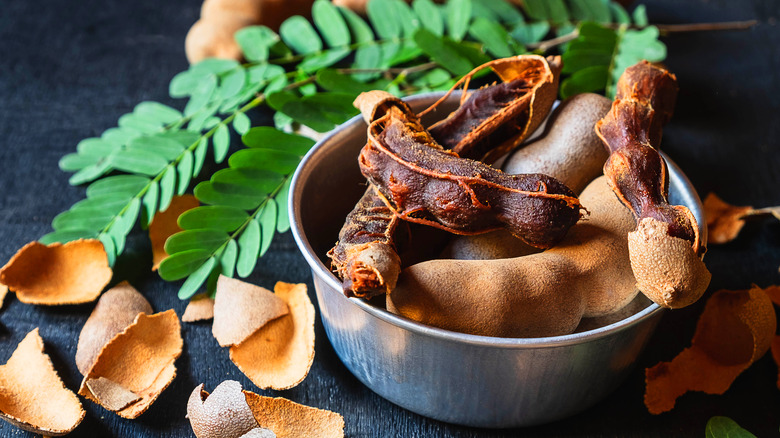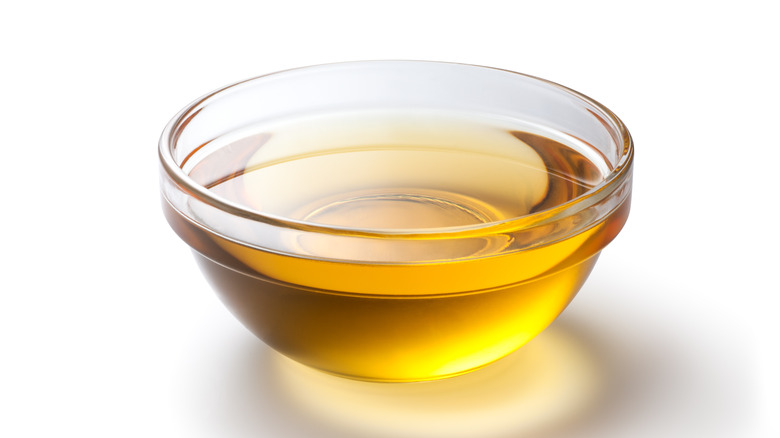Tamarind Oil Is A Lesser-Known Ingredient With A Sweet And Sour Taste
Pale brown in color, tamarind fruit almost looks like an elongated peanut still in the shell, yet inside the pod, it's an entirely different story. With a tart, tangy flavor, and a chewy, sticky texture reminiscent of dates, tamarind is known for both its sweet and sour taste. Cultivated in tropical areas worldwide, tamarind is a popular ingredient in Asian, African, and Mexican cuisine. Yet it is also a surprising element found in more old-fashioned pantry staples such as Worcestershire sauce.
You may already be acquainted with tamarind paste, particularly when creating chutneys, curries, or even beautiful Southeast Asian dishes like Pad Thai. But have you heard of tamarind oil? It's an unusual ingredient that is delicious and light while capturing sweet and sour elements reminiscent of raw fruit or paste. If you're looking for a unique and flavorful addition to your culinary repertoire, tamarind oil might just be the perfect ingredient with which to experiment.
It's all about the tamarind oil
Instead of extracting the oil from the sticky pulp, tamarind oil is taken from the seeds. The color is usually light, and the taste is slightly sweet. Yet it similarly embodies that tangy sourness that derives from the fruit. Tamarind oil flavor will vary depending on the fruit that's been used to make it; riper tamarind will be sweeter. Some store-bought tamarind oil will be soluble in water, making it easy to blend, and this characteristic also makes it convenient to use when preparing both sweet and savory recipes.
Imagine tamarind oil salad dressings, swapping out olive oil for its tamarind counterpart in baked goods, or blending it into spiced soups for a kiss of accentuated sweet-and-sour flavor. It can even be used in drinks; consider whipping up a batch of Jaljeera, a refreshing Indian drink that is spicy and tangy. Combining fennel, cumin, mint, ginger, and tamarind oil, you can make a fragrant, non-alcoholic beverage that leans into both sweet and sour notes. Or, for something simpler, you can drizzle tamarind oil over butternut squash before roasting for added sweetness!
Why do I need another oil?
While the paste version is excellent for adding body, an oil can easily add a lick of flavor without the chunks. There is relatively little guidance on using tamarind oil in recipes online, but when has that ever stopped anyone? You can play around with the oil in your favorite Asian or Indian recipes to understand how the oils will work best with traditional flavor profiles. Start with a simple stir fry with one of these Asian noodle varieties.
Aside from the flavor, you may wonder how nutritional tamarind oil is. The seeds used to create it have been proven to reduce inflammation, prevent high blood pressure, and boost our immune systems. Tamarind oil also contains higher levels of unsaturated fatty acids, making it a great alternative to coconut or palm oil, which are naturally high in saturated fat. Tamarind oil is also alcohol and gluten-free and vegan-friendly. The research on tamarind oil and its benefits has increased over the past few years, and soon it could be a pantry staple! Why not experiment with this sweet-sour oil before it hits the mainstream?


